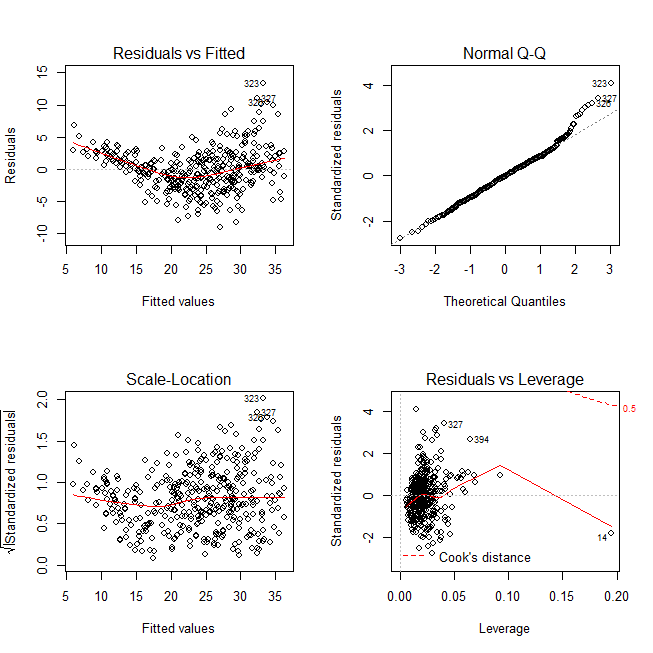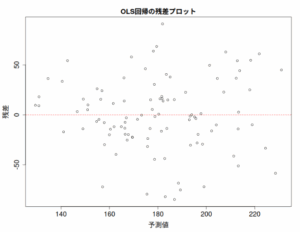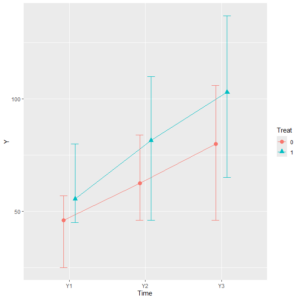R の ISLR パッケージの Auto データセットを使った分析例。
データの準備
最初の一回だけ、ISLRパッケージをインストール。
install.packages("ISLR")ISLRパッケージを呼び出して、解析開始。
library(ISLR)ISLRパッケージのAutoデータセットを用いて解析。
9変数、392例のデータ。
> str(Auto)
'data.frame': 392 obs. of 9 variables:
$ mpg : num 18 15 18 16 17 15 14 14 14 15 ...
$ cylinders : num 8 8 8 8 8 8 8 8 8 8 ...
$ displacement: num 307 350 318 304 302 429 454 440 455 390 ...
$ horsepower : num 130 165 150 150 140 198 220 215 225 190 ...
$ weight : num 3504 3693 3436 3433 3449 ...
$ acceleration: num 12 11.5 11 12 10.5 10 9 8.5 10 8.5 ...
$ year : num 70 70 70 70 70 70 70 70 70 70 ...
$ origin : num 1 1 1 1 1 1 1 1 1 1 ...
$ name : Factor w/ 304 levels "amc ambassador brougham",..: 49 36 231 14 161 141 54 223 241 2 ...
>
name以外の変数を使う。
Auto1 <- Auto[1:8]Miles per gallonを予測する因子の相関係数
origin以外の7つの変数で相関係数行列を作成する。
> round(cor(Auto1[1:7]),3)
mpg cylinders displacement horsepower weight acceleration year
mpg 1.000 -0.778 -0.805 -0.778 -0.832 0.423 0.581
cylinders -0.778 1.000 0.951 0.843 0.898 -0.505 -0.346
displacement -0.805 0.951 1.000 0.897 0.933 -0.544 -0.370
horsepower -0.778 0.843 0.897 1.000 0.865 -0.689 -0.416
weight -0.832 0.898 0.933 0.865 1.000 -0.417 -0.309
acceleration 0.423 -0.505 -0.544 -0.689 -0.417 1.000 0.290
year 0.581 -0.346 -0.370 -0.416 -0.309 0.290 1.000
Miles per gallonを国別に比較
origin別のmpg(miles per gallon=燃費)をANOVAで分析する。
originの内容は以下の通り。
Origin of car (1. American, 2. European, 3. Japanese)
res.origin <- lm(mpg ~ factor(origin), data=Auto1)
summary(res.origin)アメ車に比べヨーロッパ車は燃費がいいし、日本車はさらにいい。
Estimateがmiles per gallon推定値で、アメ車に+7.6がヨーロッパ車、+10.4が日本車。
> summary(res.origin)
Call:
lm(formula = mpg ~ factor(origin), data = Auto1)
Residuals:
Min 1Q Median 3Q Max
-12.451 -5.034 -1.034 3.649 18.966
Coefficients:
Estimate Std. Error t value Pr(>|t|)
(Intercept) 20.0335 0.4086 49.025 <2e-16 ***
factor(origin)2 7.5695 0.8767 8.634 <2e-16 ***
factor(origin)3 10.4172 0.8276 12.588 <2e-16 ***
---
Signif. codes: 0 ‘***’ 0.001 ‘**’ 0.01 ‘*’ 0.05 ‘.’ 0.1 ‘ ’ 1
Residual standard error: 6.396 on 389 degrees of freedom
Multiple R-squared: 0.3318, Adjusted R-squared: 0.3284
F-statistic: 96.6 on 2 and 389 DF, p-value: < 2.2e-16
Miles per gallonを予測する重回帰モデルの作成
全部の変数でmpgを推測するモデルを作成してみる。
res1 <- lm(mpg ~ cylinders + displacement + horsepower + weight + acceleration + year + factor(origin), data=Auto1)
summary(res1)Adjusted R-squaredが0.8205と高く、この重回帰モデルの説明変数は目的変数をよく説明している。
displacement (排気量), weight, year, originは統計学的有意に関連あり。
例えば、yearが1増加する(1年新しくなる)と、mpgが0.777増加(燃費向上)する。
> summary(res1)
Call:
lm(formula = mpg ~ cylinders + displacement + horsepower + weight +
acceleration + year + factor(origin), data = Auto1)
Residuals:
Min 1Q Median 3Q Max
-9.0095 -2.0785 -0.0982 1.9856 13.3608
Coefficients:
Estimate Std. Error t value Pr(>|t|)
(Intercept) -1.795e+01 4.677e+00 -3.839 0.000145 ***
cylinders -4.897e-01 3.212e-01 -1.524 0.128215
displacement 2.398e-02 7.653e-03 3.133 0.001863 **
horsepower -1.818e-02 1.371e-02 -1.326 0.185488
weight -6.710e-03 6.551e-04 -10.243 < 2e-16 ***
acceleration 7.910e-02 9.822e-02 0.805 0.421101
year 7.770e-01 5.178e-02 15.005 < 2e-16 ***
factor(origin)2 2.630e+00 5.664e-01 4.643 4.72e-06 ***
factor(origin)3 2.853e+00 5.527e-01 5.162 3.93e-07 ***
---
Signif. codes: 0 ‘***’ 0.001 ‘**’ 0.01 ‘*’ 0.05 ‘.’ 0.1 ‘ ’ 1
Residual standard error: 3.307 on 383 degrees of freedom
Multiple R-squared: 0.8242, Adjusted R-squared: 0.8205
F-statistic: 224.5 on 8 and 383 DF, p-value: < 2.2e-16
残差プロット。
予測式の性能チェック。
Residuals vs. FittedとScale-Locationは水平な赤い線が理想。
Normal Q-Qはすべての点が斜めの線上であるのが理想。
Residuals vs. Leverageは赤い点線より外側に点がないのが理想。
Residual vs. Fittedは、厳密にいうと、heteroscedasticity(分散不均一性)に見える。
Normal Q-Qは、Quartileが大きいところでずれがある。
Scale-LocationとResiduals vs. Leverageは取り立てて問題点はない。
layout(t(matrix(c(1:4),nr=2))) plot(res1)

交互作用項を入れた解析
例として、yearとdisplacementの交互作用項を追加して再度解析。
res2 <- lm(mpg ~ cylinders + displacement + horsepower + weight + acceleration + year + year:displacement + factor(origin), data=Auto1)
summary(res2)displacementとyearの交互作用項を足してみたところ、
displacement:year: p=3.51e-12 ***
という結果を得た。
この項は統計学的有意であった。
> summary(res2)
Call:
lm(formula = mpg ~ cylinders + displacement + horsepower + weight +
acceleration + year + year:displacement + factor(origin),
data = Auto1)
Residuals:
Min 1Q Median 3Q Max
-7.5860 -2.0066 0.0133 1.6529 12.1025
Coefficients:
Estimate Std. Error t value Pr(>|t|)
(Intercept) -6.451e+01 7.829e+00 -8.241 2.77e-15 ***
cylinders 2.606e-02 3.103e-01 0.084 0.9331
displacement 2.806e-01 3.642e-02 7.704 1.15e-13 ***
horsepower -3.370e-02 1.306e-02 -2.580 0.0103 *
weight -6.116e-03 6.212e-04 -9.844 < 2e-16 ***
acceleration 1.048e-01 9.237e-02 1.134 0.2574
year 1.375e+00 9.645e-02 14.261 < 2e-16 ***
factor(origin)2 2.588e+00 5.323e-01 4.861 1.71e-06 ***
factor(origin)3 2.453e+00 5.224e-01 4.695 3.73e-06 ***
displacement:year -3.560e-03 4.953e-04 -7.187 3.51e-12 ***
---
Signif. codes: 0 ‘***’ 0.001 ‘**’ 0.01 ‘*’ 0.05 ‘.’ 0.1 ‘ ’ 1
Residual standard error: 3.107 on 382 degrees of freedom
Multiple R-squared: 0.8451, Adjusted R-squared: 0.8415
F-statistic: 231.6 on 9 and 382 DF, p-value: < 2.2e-16
多重共線性をチェック
多重共線性のチェックのためにVIF(Variance Inflation Factor)を計算。
VIFについてはこちらを参照。

car パッケージの vif() 関数を使う。
library(car) で呼び出せない場合、install.packages(“car”) で一回だけインストールを行う。
> library(car)
要求されたパッケージ carData をロード中です
> vif(res1)
GVIF Df GVIF^(1/(2*Df))
cylinders 10.737771 1 3.276854
displacement 22.937950 1 4.789358
horsepower 9.957265 1 3.155513
weight 11.074349 1 3.327814
acceleration 2.625906 1 1.620465
year 1.301373 1 1.140777
factor(origin) 2.096060 2 1.203236GVIFの列を確認する。
慣例として、5以上は多重共線性の可能性あり、10以上は多重共線性の可能性がかなり高いと判断する。
displacementが5に近く多重共線性の可能性を考え、外してみて再解析してみる。
GVIFが5に近いものはなくなった。
> res11 <- lm(mpg ~ cylinders + horsepower + weight + acceleration + year + factor(origin), data=Auto1)
> vif(res11)
GVIF Df GVIF^(1/(2*Df))
cylinders 6.249795 1 2.499959
horsepower 9.096327 1 3.016012
weight 9.260848 1 3.043164
acceleration 2.600476 1 1.612599
year 1.285826 1 1.133943
factor(origin) 1.794849 2 1.157463
> summary(res11)
Call:
lm(formula = mpg ~ cylinders + horsepower + weight + acceleration +
year + factor(origin), data = Auto1)
Residuals:
Min 1Q Median 3Q Max
-9.2846 -2.1094 0.0135 1.8127 13.4034
Coefficients:
Estimate Std. Error t value Pr(>|t|)
(Intercept) -1.861e+01 4.726e+00 -3.939 9.71e-05 ***
cylinders 1.610e-01 2.479e-01 0.649 0.516474
horsepower -5.554e-03 1.325e-02 -0.419 0.675378
weight -5.880e-03 6.059e-04 -9.704 < 2e-16 ***
acceleration 4.882e-02 9.886e-02 0.494 0.621702
year 7.593e-01 5.206e-02 14.585 < 2e-16 ***
factor(origin)2 2.023e+00 5.383e-01 3.758 0.000198 ***
factor(origin)3 2.317e+00 5.316e-01 4.359 1.68e-05 ***
---
Signif. codes: 0 ‘***’ 0.001 ‘**’ 0.01 ‘*’ 0.05 ‘.’ 0.1 ‘ ’ 1
Residual standard error: 3.344 on 384 degrees of freedom
Multiple R-squared: 0.8197, Adjusted R-squared: 0.8164
F-statistic: 249.4 on 7 and 384 DF, p-value: < 2.2e-16
情報量規準でモデル診断
AIC(赤池情報量規準)、BIC(ベイズ情報量規準)の二つでモデル診断。
当てはまりの良さをチェック。
AIC(res1, res11, res2)
BIC(res1, res11, res2)値が小さいほうが当てはまりがよい。
AICもBICも交互作用項を入れたモデルが最も当てはまりがよい。
> AIC(res1, res11, res2)
df AIC
res1 10 2060.928
res11 9 2068.848
res2 11 2013.216
> BIC(res1, res11, res2)
df BIC
res1 10 2100.64
res11 9 2104.59
res2 11 2056.90
まとめ
R の ISLR パッケージにある Auto データで、重回帰分析をやってみた。
順番としては、先行研究や理論をもとにモデルを作成し、残差プロットや情報量規準で当てはまりを診断する。
参考になれば。






コメント